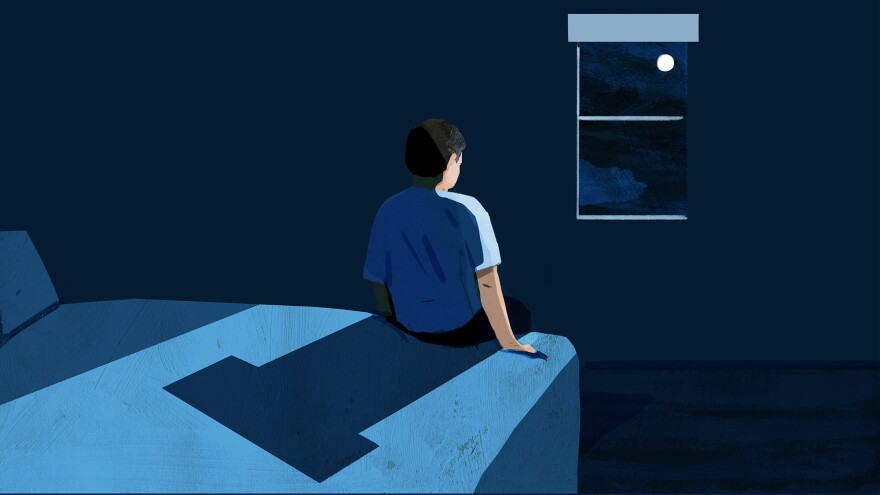Jon McHann, 56, got started on prescription opioids the way a lot of adults in the U.S. did: he was in pain following an accident. In his case, it was a fall."I hit my tailbone just right, and created a severe bulging disc" that required surgery, McHann says.McHann, who lives in Smithville, Tenn., expected to make a full recovery and go back to work as a heavy haul truck driver. But 10 years after his accident, he's still at home."After the surgery the pain was just excruciating," McHann recalls. "I was unable to function." His spinal problems turned out to be more complicated and hard to treat. And he developed other health problems, too. He had several more surgical procedures for his back, but he got no relief. He says on days when his pain is through the roof, "I can't open my eyes because I know if I blink it's going to hurt."His doctor prescribed methadone, a powerful opioid. He stayed on the drug for seven years."It helped immensely, it brought my pain down to a 5 or 6 [on a 10 point scale]," McHann says. "I could function fairly well throughout the day. I could go to church every weekend, I could help my wife shop, I could help around the house a little bit."McHann knew the risksof opioid drugs, including the risk of dependence. "It was a concern to me," he says. His goal was to get off the drugs. But for many years, it felt like the benefits of the pain relief outweighed the risks.But as concern about the opioid epidemic grew, McHann started getting pushback from his doctors. They began reducing the strength and dose of his prescription. "Every time I saw a clinician, my opioids were reduced," McHann says.As the dosage was decreased, his pain began to increase and he worried that he'd be cut off the drug. "Life wasn't going to be worth living if I couldn't get the pain under control," McHann says.McHann is not alone; pain is one of the most common and debilitating medical conditions, with about one-third of Americans dealing with some form of acute or chronic pain. In 2014, 3 to 4 percent of adults were prescribed opioid painkillers long term — 9.6 to 11.5 million people.In response to the epidemic of opioid addiction and deaths, in 2016 the Centers for Disease Control and Prevention released guidelines urging physicians to try non-opioid methods first for chronic pain. In a viewpoint published last month in JAMA, the journal of the American Medical Association, CDC officials wrote that while illicit opioids such as fentanyl seem to be driving the recent increase in opioid-related overdose deaths, "unnecessary exposure to prescription opioids must be reduced to prevent development of opioid use disorder in the first place."But figuring out what's unnecessary, and how best to reduce the risk, can be a challenge."I have certainly met a good number of patients who have not found better options and are now taking opioids for chronic pain," says Stefan Kertesz, a physician who is a professor at the University of Alabama at Birmingham, certified in addiction medicine.Kertesz, who is not McHann's doctor, says some physicians feel caught between a rock and a hard place. With the rise in opioid overdose deaths, there's a lot of pressure to limit prescriptions.The CDC guidelinespoint to the serious risks of high dosages and long-term use, including addiction. They offerguidanceto physicians on how to taper doses, or discontinue the use of the drugs.Kertesz agrees that opioids have been prescribed too much in the past. "Absolutely, [doctors] caused new addiction in some people by prescribing too aggressively," Kertesz says. "But the idea that you can simply take [the drugs] away, sometimes from people who need them, is mistaken."Kertesz' position is controversial. His stance led me to wonder whether he had ever worked for the pharmaceutical companies that promoted these drugs. "I have never worked a day in my life for the pharmaceutical industry and I have no interest in doing it in the future," Kertesz says. "Do I want to be in situation where I'm forced to take people off a medicine that is helping them? No! "Going forward, Kertesz says he hopes that new medications will be developed that will have less potential for addiction, "but I think human suffering is really complicated and doctors need to have the room to make professional decisions — together with their patients — about what works best for them."As for Jon McHann, last month he had another procedure aimed at easing nerve compression in his back, and for now he's optimistic. His pain is diminished, and he's on a much lower dose of medication. He's taking Percocet, which gives him a lower dose of opioids and acetaminophen. "I'm hoping to be opioid free, I don't know if I'll get there, but I want to try." Copyright 2017 NPR. To see more, visit http://www.npr.org/.
Is There A Way To Keep Using Opioid Painkillers And Reduce Risk?



